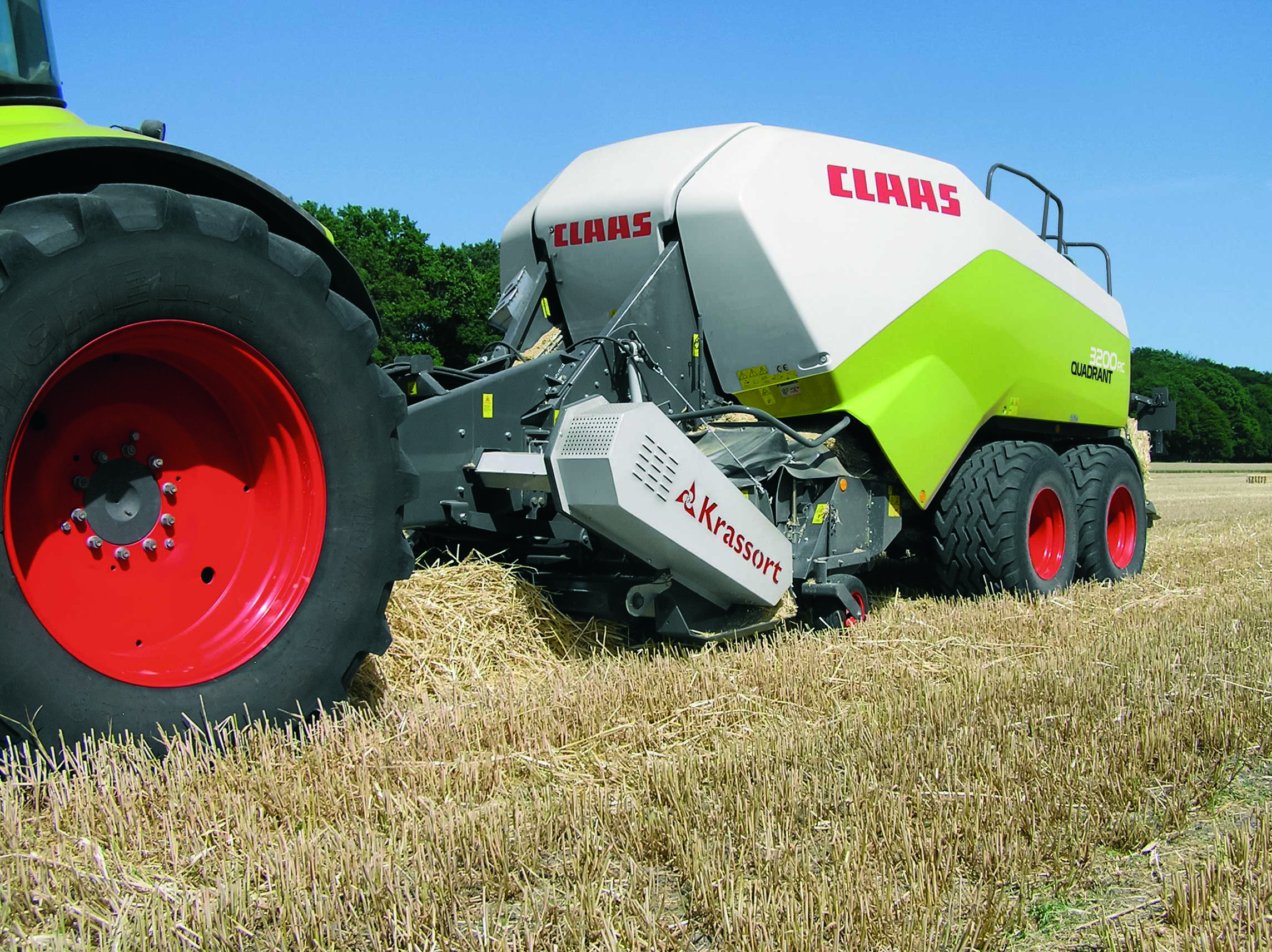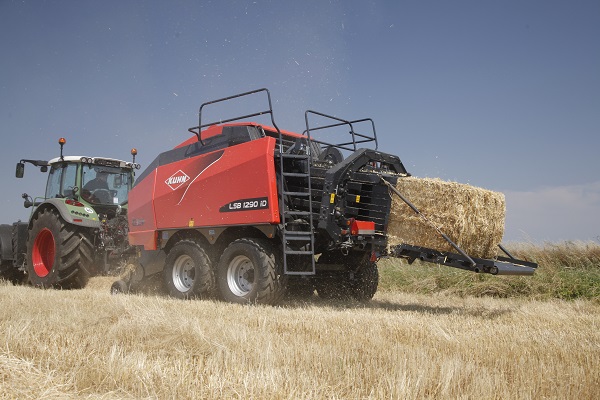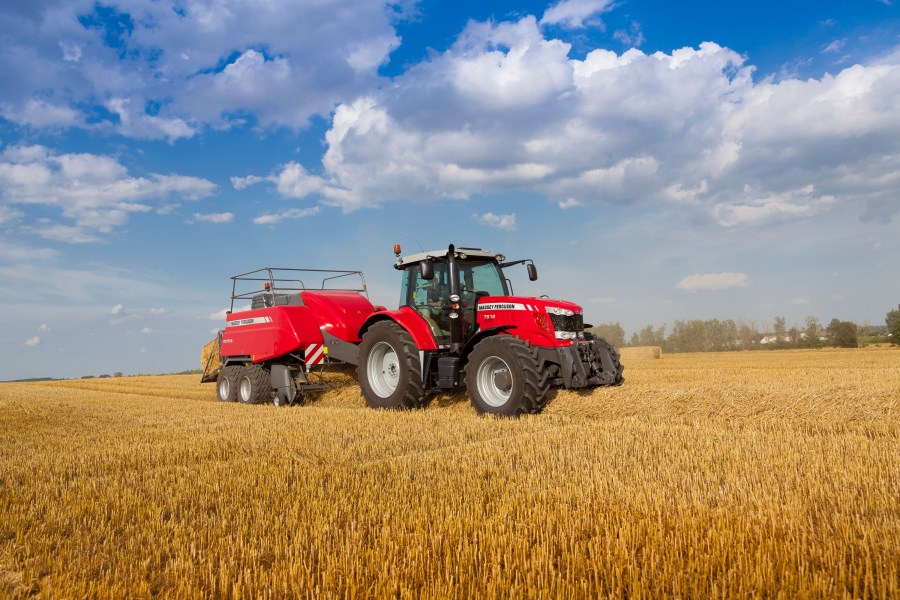Adding a knife bank or chopper to a large square baler delivers a number of benefits, helping to increase density as well as making bales more convenient to transport and use. CPM looks at the latest developments.
The bales are heavier, denser and, importantly easier to process in mixer wagons.
By Mick Roberts
Although big square balers can deliver enormous packages of straw, users are always looking for a bit more. Larger, heavier bales cut the amount of handling and make best use of transport space. But the denser material can make them more difficult to handle.
Step in the baler-mounted cutter or chopper. First developed for those looking to slice grass going into bales for silage, they’re being used increasingly to chop straw as well. Again the bales are heavier, denser and, importantly easier to process in mixer wagons.
When used for bedding, the bales break apart more easily and the chopped straw absorbs more moisture. This saves straw and the shorter material in the resulting manure is easier to spread.
For merchants and contractors, chopped bales deliver the ultimate advantage of making full use of lorry space. Indeed, some users report that with latest high density and chopped bales they need to be careful not to overload the trucks – even with straw.
MF 2270 HD ProCut
The Massey Ferguson 2270 HD, which makes 120x90cm bales, is equipped with 26 knives, mounted in two hydraulically selectable knife banks held in a magazine. Operators can change chop lengths by engaging or lowering each bank.
Releasing a catch on the side of the machine allows the whole magazine to slide out to the left of the baler on rails and roller bearings. Knives are removed, without tools, by releasing a locking pin and lifting them out.
New Quad augers, fitted on either side of the pick-up, are designed to increase capacity and provide an even feed material to the rotor. The 650mm diameter ProCut rotor is fitted with 26mm cast steel fingers, with 108 arranged in a V formation on the 120cm balers.
The replaceable fingers are in three sections and are clamped to the rotor tube with bolts, explains MF’s Mark Grigson. “This mounting means, unlike fingers welded to rotors, they can be replaced quickly without having to remove the rotor. This saves time and, because it’s easy to do, operators will change them promptly, which maintains optimum feeding and baler performance,” he adds.
Claas Quadrant FC/RC
The Claas Quadrant 3300, which makes 120x90cm bales, is available with Roto Cut – a conventional 25-knife system or Fine Cut, which provides up to 51 knives for those looking for a shorter chop in straw.
A further option for those requiring even shorter material is Special Cut. This is a separate flail-chopping unit, mounted in front of the pick-up and processes straw with flails before it enters the pick-up.
The rotor, which spins at 3,000rpm, is fitted with 90 serrated flail knives mounted in a helical pattern and this has the effect of ‘sucking up’ the straw.

Claas is one of a number of makers offering a front-mounted flail chopper that provides a finer chop by processing the straw ahead of the pick-up.
The chopper runs at least 250mm above the ground and this, says Claas, means it doesn’t come into contact with the ground and prevents any stones or other foreign objects entering.
Depending on straw quality, it’s also possible to swing in a further two rows of 45 stationary knives, which work like shear bars to produce an even finer chop.
For those requiring more conventional on-bale cutting, Claas offers Roto Cut and for shorter lengths its Fine Cut knife system. Blades are held in a drawer unit, which pulls out to either side to provide easy access for servicing and maintenance.
Blades are arranged in four groups. A simple lever is used to select the number of knives in work and they’re moved in and out hydraulically. Roto Cut systems offer a choice of 25, 13, 12 or 6 knives, while the Fine Cut doubles this up to 51, 26, 13 or 12.
John Deere L 1534
The John Deere L 1534 large square baler, which produces 120x90cm bales, is available with the 23-knife MaxiCut HC system. There’s also a less well known option of a front-mounted pre-chopper unit for finer chopping.
The MaxiCut uses the rotor to pull the material through 23 static knives behind the pick-up. Operators can choose to use 11, 12 or all 23 knives by moving a hydraulic valve on the machine and then selecting them from the cab control-box.
Knives are held in a cassette that, after releasing a couple of catches, pulls out to one side for servicing and maintenance. The knives are protected from damage by accumulators in the hydraulic system, while the slots are kept clear by an automatic self-cleaning system that engages and withdraws the knives at pre-set intervals.
John Deere also offers a front-mounted pre-chopper, which uses flails to process the straw ahead of the pick-up. Previously available as a retro-fit unit, this is soon to be a factory-fit option.
Kuhn LSB 1290 iD
A novel plunger design on the Kuhn LSB 1290 iD baler is said to help produce bales that are 25% denser than those from conventional machines. And for those looking to cut the straw, the machine

The recently introduced Kuhn LSB 1290 iD baler uses a two-part plunger to compress the bale in two stages, which increases the density by up to 25%.
can also be equipped with the OmniCut knife system.
According to Kuhn, achieving the extra density requires twice the force exerted by a conventional plunger. So, to counter this, its Twinpact-plunger is divided into two parts with a ‘crank’ in the driveline moving the upper and lower parts separately, compressing the bale in two steps.
This, adds the firm, increases the density in bales without creating extreme forces on the machine. It also says the power requirement is similar to that for other, conventional big balers making 120x90cm bales.
Crop is fed from the pick-up by a 600mm diameter OptiFeed rotor fitted with steel tines, which are bolted into position, rather than welded. The cutting version, called OmniCut has 23 knives, providing a theoretical chop length of 45mm. These are engaged hydraulically, using a valve that offers the choice to engage 0, 11, 12 or all 23 knives. The hydraulics also provide protection for the knives.
The knives are held in a cassette frame that, after lowering, slides out to the right-hand side of the machine, providing access to servicing and maintenance. Knives can be removed without tools.
Krone BiG Pack HDP
Increasing bale weight from 400 to 500kg in a 4t/ha straw yield crop means there are two bales/ha less to collect, transport and store, says Krone, which has developed the HDP system aimed at making 25% higher density bales.
As well as increasing density it has also developed a high speed version – the HDP II, providing a total of four different versions of the 120x90cm BiG Pack 1290, including high speed and chopping options.
The XC models are equipped with the XCut system, which has 26 knives in the 120cm-chamber machines. The knives can be selected in sets and when all are engaged it provides a chop length down to about 44mm. Knives are held in trays that pull out to the side for servicing and maintenance.
For a finer chop – down to 21mm – Krone offers the PreChop system. This mounts in front of the pick-up and chops the material with 96 reversible rotating blades fitted in a helical pattern on a rotor working at 3000rpm. These work against 47 counter blades that can be moved to five different positions to alter the chop intensity. Krone says the system not only chops the straw, but also shreds it apart, which makes it more absorbent for bedding and better for incorporation into feed in a mixer wagon.
New Holland1290
As well as providing a CropCutter conventional knife option on its BigBaler 1290, New Holland also offers the TwinCutter flail-type chopper, which produces a fine chop while also shredding the straw.
As well as helping to increase bale density, the firm says this super fine chop enhances the combustion profiles of bales destined for straw-fired power stations. The finely chopped bales are also more absorbent and easier to spread when used as bedding, as well as handled easily by mixers for those feeding total mixed rations, it adds.
The TwinCutter, which fits in front of the pick-up, chops straw with a rotor fitted with 44 knives and two rows of counter knives, which are adjustable to alter the chop length. The chopper is lifted in and out of work on two hydraulic rams, with the option of gauge wheels.
The CropCutter alternative offers a choice of an 8cm medium chop for bedding or a short 4cm cut, which is recommended for silage, fodder and biomass applications. The incoming crop is gathered by tines arranged in ‘W’ formation on the 120cm wide rotor, which matches the width of the pre-compression chamber.
The 29 knives are held in a knife drawer which pulls out to the side of the baler on self-supporting runners to provide clear access to remove the knives and for maintenance.
New baler packs in a better performance
Baling is an important part of the business for BHE Agricultural Contractors, which is operated by Simon Dunn, who also farms from his base at Studland Farm, Sproxton, North Yorks. As well as round baling, he runs three large square balers that, between them, make about 30,000 bales/year – about a third of which are haylage and silage, while the remaining majority is straw.
“Chopping grass on the baler makes better silage, which is easier to feed and mix. But chopped straw is also a big part of the business now – probably accounting for half of all the bales we make,” he says.
Last season he had the opportunity to try one of the first Massey Ferguson MF 2270 HD machines equipped with the company’s new ProCut system. This was hired from Big Bale North that, as its name suggests, specialises in hiring, selling and servicing big square balers.
“One of the advantages of hiring such high capital cost equipment is it allows me to really test the machine or concept before investing,” he explains. “We weren’t getting on so well with the baler the MF 2270 HD replaced, so being able to change the machine worked really well for us.”
The change made a big difference to the baling operation, he adds. “All I really want is headache-free motoring and the Massey Ferguson delivered this from the very first day. It’s not the fastest machine, but it’s reliable and this means it just keeps on working away, making good quality bales,” he comments.
The 120x90cm chopped-straw bales weigh about 550kg, which is about 10% more than the ones that haven’t been chopped. This means he can fill the trucks to a full payload, which is a big advantage. “The moisture content is always important for all straw bales and probably even more so for the high density chopped bales. The straw needs to be at 15% or less – we can’t sell damp bales.”
The baler is powered by a 280hp, Fendt 828 Vario, which he says, is a perfect match for the job, providing the power to climb the hills, while the Vario continuously variable transmission allows the operator to always work at the optimum speed.
“The whole operation runs as it should and the new baler has solved many previous problems – now every day is a good day,” comments Simon Dunn. “It’s providing trouble-free baling, making about 10,000 bales from July to Sept. It’s not down to one particular feature, I think it’s a good all-round performer that uses older, well proven technology, but with refinements that bring it up to date”
Chopping on the baler does, however, create more debris and dust in dry conditions and he singles out the full-width impeller knotter fan for praise, adding it’s a big improvement on the system employed on his previous machine.
“Also, even with the knives set to the shortest chop this doesn’t affect the tying – it doesn’t seem to matter. The baler still makes good quality, solid and well formed bales that come out looking good and maintain their shape,” he adds.
After using the baler for a whole season and in all crops he now has the confidence to consider buying, rather than hiring the machine. “In the long term it’s cheaper to own equipment and have something to sell at the end. Hiring does, however, allow me to try new products before investing £100,000 in a new machine,” he adds.
Massey Ferguson announced the new ProCut system for its MF 2200 Series balers last Aug. The new system introduced a number of design changes including clamp-on fingers for the feeder rotor and a hydraulic drop-down bed with the knives held in a new magazine, which rolls out to the left-hand side for servicing.




